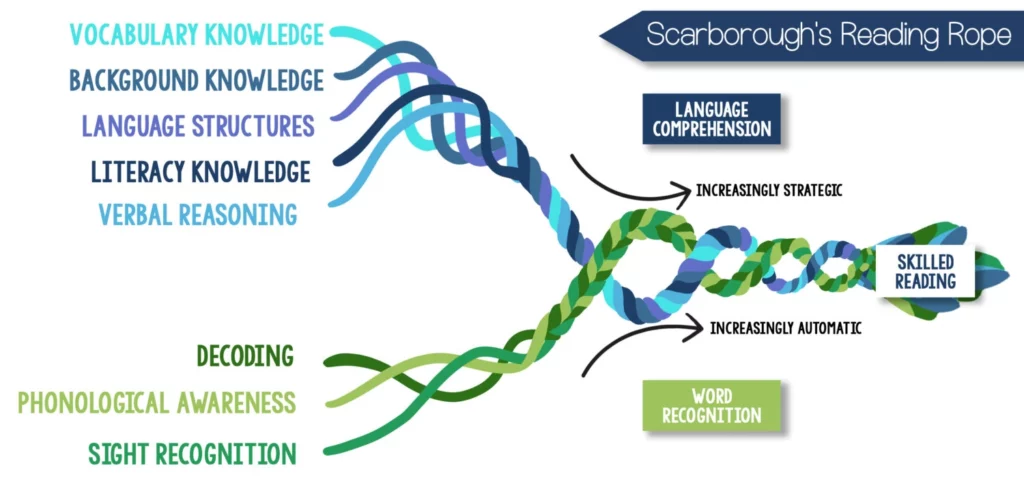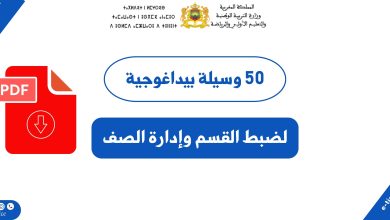6 Key Tips for Using Scarborough’s Reading Model
فهرس المقالة
Teaching reading is one of the most impactful roles you can take on as an educator. The ability to help students unlock the power of reading sets the foundation for their entire academic journey and beyond. But, as you likely know, reading is not a one-size-fits-all skill. Each student brings a unique set of challenges and strengths when it comes to reading. So, how do you effectively guide your students through this complex process?
Scarborough’s Reading Model offers an answer. With its research-backed approach to understanding the intricacies of reading development, this model is a powerful tool for teachers. By breaking reading down into two essential components, it gives you the insight you need to create balanced, effective instruction for your students.
In this guide, you’ll learn how Scarborough’s Reading Model can become your go-to framework for teaching reading in the classroom. From understanding the foundational elements of the model to practical tips for its implementation, this article will equip you with everything you need to help your students succeed.
What is Scarborough’s Reading Model?
Scarborough’s Reading Model, also known as the Reading Rope, is a comprehensive framework that helps educators understand the various factors involved in reading. The model, developed by Dr. Hollis Scarborough, outlines two primary strands that contribute to reading development: word recognition and language comprehension.
Word Recognition
Word recognition refers to the ability to decode written words into their correct sounds and meanings. It’s the foundation of fluent reading. If a student struggles with recognizing words quickly, their ability to comprehend the text as a whole will suffer. Word recognition can be broken down into three sub-skills:
- Phonological Awareness: The ability to recognize and manipulate sounds in spoken words.
- Decoding: The skill of converting written words into their corresponding sounds.
- Sight Word Recognition: The quick and automatic recognition of high-frequency words without the need to sound them out.
Language Comprehension
The second strand of Scarborough’s Reading Model focuses on language comprehension. This is the ability to understand and make meaning from the words you read. It’s not enough to simply recognize words; students must also be able to understand the language within the context of a passage. Language comprehension includes the following components:
- Vocabulary: A wide vocabulary helps students understand more of what they read.
- Syntax: Understanding sentence structure and grammar rules aids in comprehension.
- Background Knowledge: Drawing on prior knowledge helps students connect new information to what they already know.
- Reading Comprehension Strategies: These include the ability to infer meaning, summarize information, and engage critically with the text.
Together, these two strands form a “rope” of reading skills. When both strands are strong, students develop into proficient readers capable of both recognizing words and understanding their meaning.
The Key Elements of Scarborough’s Reading Rope

To help you further understand how Scarborough’s Reading Model works in practice, let’s dive deeper into the individual elements of the Reading Rope.
Word Recognition
Word recognition is critical in developing fluency and automaticity in reading. It allows students to focus on the meaning of the text instead of struggling with decoding each word. Let’s break down the key components that support word recognition:
- Phonological Awareness:
Phonological awareness is one of the first skills students need to develop. Without it, they’ll have trouble understanding how sounds in words work. Phonological awareness involves skills like rhyming, segmenting, and blending sounds in words. Activities like rhyming games and sound segmentation exercises are fantastic for strengthening phonological awareness. - Decoding:
Decoding is the ability to translate written letters into sounds. It’s essential for reading fluency and enables students to “sound out” unfamiliar words. Phonics-based instruction plays a significant role in helping students develop decoding skills, especially when they are beginning readers. - Sight Word Recognition:
Sight words are high-frequency words that don’t always follow standard phonetic rules (such as “the,” “said,” and “was”). Students should aim to recognize these words by sight to improve reading speed and fluency. Sight word practice is crucial for early readers, as it helps them become more efficient in their reading.
Language Comprehension
Language comprehension is where the deeper, cognitive processes of reading come into play. A student can decode a word perfectly but still struggle with understanding the meaning of the sentence or passage. Here are the key components of language comprehension:
- Vocabulary:
A student’s vocabulary directly impacts their ability to understand what they read. A rich vocabulary allows students to make sense of the text and engage with it on a deeper level. Strategies like teaching vocabulary in context, using graphic organizers, and encouraging reading diverse genres can enhance vocabulary development. - Syntax:
Syntax refers to the structure of sentences and how words fit together to create meaning. Students need to understand how different parts of speech come together to form meaningful sentences. Teaching sentence structure through examples and activities can help students grasp how syntax works. - Background Knowledge:
The more background knowledge students have on a topic, the better they can comprehend the material they read. Encouraging students to make connections between what they’re reading and what they already know will help them retain new information and make it easier for them to infer meaning from the text. - Reading Comprehension Strategies:
Once a student is decoding and understanding individual words, they must learn how to piece them together to form meaning. Teaching comprehension strategies such as summarizing, questioning, and making predictions helps students become active readers who engage critically with the text.
How Scarborough’s Reading Model Supports Teachers in the Classroom
By understanding the dual strands of Scarborough’s Reading Model, you are equipped to offer a more balanced, individualized approach to teaching reading. The key is to develop both word recognition and language comprehension in tandem. Here are some practical ways to apply the model in your classroom:
- Word Recognition Focus:
Incorporate activities that develop phonological awareness and decoding skills. Phonics games, flashcards, and repetitive reading exercises can help students strengthen their word recognition abilities. Make sure to provide plenty of opportunities for students to practice sight word recognition as well. - Language Comprehension Focus:
Work on building your students’ vocabulary and comprehension skills by reading diverse materials together. Encourage students to discuss what they’ve read and use reading comprehension strategies to deepen their understanding. Ask open-ended questions that encourage critical thinking. - Tailored Instruction:
Every student has different needs, so it’s important to adjust your teaching strategies based on individual progress. For example, some students may need more support with word recognition, while others may benefit from extra focus on comprehension. Providing differentiated instruction ensures that all students have the opportunity to succeed.
How to Assess Reading Development Using Scarborough’s Model
Effective assessment is key to tracking your students’ progress and adjusting your teaching methods accordingly. Scarborough’s Reading Model provides a framework for assessing both word recognition and language comprehension:
- Assessing Word Recognition:
Conduct fluency assessments and phonics tests to measure students’ ability to recognize and decode words. Quick word recognition is a good indicator of overall reading fluency. - Assessing Language Comprehension:
Use reading comprehension tests, such as asking students to summarize a passage or answer questions about a text. You can also gauge comprehension through discussions and projects where students demonstrate their understanding of the material.
Implementing Scarborough’s Model in Your Teaching Practice
To successfully implement Scarborough’s Reading Model in your classroom, create a weekly reading plan that focuses on both word recognition and language comprehension. Here’s an example of what that might look like:
| Day | Focus Area | Activity |
|---|---|---|
| Monday | Word Recognition | Phonics games, flashcard review |
| Tuesday | Vocabulary Development | Introduce new vocabulary words, word maps |
| Wednesday | Reading Fluency | Practice reading short texts aloud |
| Thursday | Comprehension Strategies | Summarize a story, group discussion |
| Friday | Review and Reinforcement | Review the week’s lessons through games or quizzes |
Common Challenges and Solutions for Teachers
While Scarborough’s Reading Model offers an effective approach to teaching reading, you may face some challenges along the way. Here are some common obstacles and solutions:
- Challenge: Diverse student reading levels.
Solution: Differentiate your instruction to meet the needs of all learners. Provide additional support to struggling readers while offering more challenging materials to advanced students. - Challenge: Limited resources.
Solution: Use free or low-cost resources such as online phonics games, reading apps, and printable worksheets to support your students. - Challenge: Keeping students motivated.
Solution: Incorporate interactive activities, games, and group work to keep students engaged. Celebrate small milestones to encourage continued progress.
FAQ Section
What are the two main components of Scarborough’s Reading Model?
Scarborough’s Reading Model includes word recognition and language comprehension. Word recognition involves skills such as phonological awareness and decoding, while language comprehension focuses on understanding vocabulary, sentence structure, and background knowledge.
How can I apply Scarborough’s Reading Model in my classroom?
You can apply Scarborough’s model by focusing on both word recognition and language comprehension in your lesson plans. Incorporate phonics-based activities, vocabulary-building exercises, and reading comprehension strategies.
What is the benefit of using Scarborough’s Reading Model for reading instruction?
Scarborough’s Reading Model provides a balanced approach to teaching reading. It addresses both the technical skills of decoding words and the deeper cognitive processes involved in understanding text, ensuring that students develop strong, well-rounded reading abilities.
Conclusion: Empower Your Students with Scarborough’s Reading Model
By adopting Scarborough’s Reading Model in your teaching practice, you can help your students develop the essential skills needed for reading success. With its focus on both word recognition and language comprehension, this model provides a clear, research-backed framework for nurturing proficient, confident readers.
Now that you have a solid understanding of Scarborough’s Reading Model, take the next step in implementing these strategies in your classroom. Remember, every student is unique, and by tailoring your instruction to meet their individual needs, you can help them become the skilled readers they are capable of being.
Ready to make a lasting impact on your students’ reading abilities? Start integrating Scarborough’s Reading Model today!


